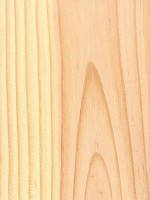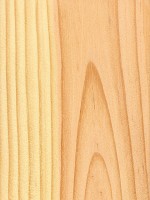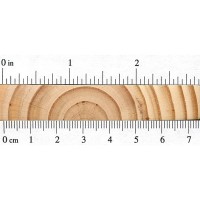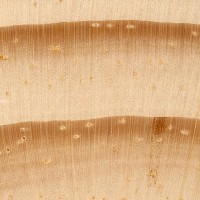 |
Common Name(s): Table Mountain Pine Scientific Name: Pinus pungens Distribution: Eastern United States (primarily Appalachian Mountain region) Tree Size: 50-65 ft (15-20 m) tall, 1-2 ft (.3-.6 m) trunk diameter Average Dried Weight: 36 lbs/ft3 (575 kg/m3) Specific Gravity (Basic, 12% MC): .49, .58 Janka Hardness: 730 lbf (3,250 N) Modulus of Rupture: 11,600 lbf/in2 (80.0 MPa) Elastic Modulus: 1,550,000 lbf/in2 (10.69 GPa) Crushing Strength: 6,830 lbf/in2 (47.1 MPa) Shrinkage: Radial: 3.4%, Tangential: 6.8%, Volumetric: 10.9%, T/R Ratio: 2.0 |
Color/Appearance: Heartwood is reddish brown, sapwood is yellowish white.
Grain/Texture: Straight grained with a medium texture.
Endgrain: Large resin canals, numerous and evenly distributed, mostly solitary; earlywood to latewood transition abrupt, color contrast relatively high; tracheid diameter medium-large.
Rot Resistance: The heartwood is rated as moderate to low in decay resistance.
Workability: Overall, Table Mountain Pine works fairly well with most tools, though the resin can gum up tools and clog sandpaper. Table Mountain Pine glues and finishes well.
Odor: Has a distinct smell that is shared among most species in the Pinus genus.
Allergies/Toxicity: Working with pine has been reported to cause allergic skin reactions and/or asthma-like symptoms in some people. See the articles Wood Allergies and Toxicity and Wood Dust Safety for more information.
Pricing/Availability: Table Mountain Pine is sold and mixed interchangeably with other species as Southern Yellow Pine, which is widely available as a construction lumber for a modest price.
Sustainability: This wood species is not listed in the CITES Appendices, and is reported by the IUCN as being a species of least concern.
Common Uses: Southern Yellow Pine is used for heavy construction, such as: bridges, beams, poles, railroad ties, etc. It’s also used for making plywood, wood pulp, and veneers.
Comments: Table Mountain Pine is technically considered to be in the group of southern yellow pines, though it is a very minor species.
- Austrian Pine (Pinus nigra)
- Caribbean Pine (Pinus caribaea)
- Eastern White Pine (Pinus strobus)
- Jack Pine (Pinus banksiana)
- Jeffrey Pine (Pinus jeffreyi)
- Khasi Pine (Pinus kesiya)
- Limber Pine (Pinus flexilis)
- Loblolly Pine (Pinus taeda)
- Lodgepole Pine (Pinus contorta)
- Longleaf Pine (Pinus palustris)
- Maritime Pine (Pinus pinaster)
- Ocote Pine (Pinus oocarpa)
- Patula Pine (Pinus patula)
- Pinyon Pine (Pinus edulis)
- Pitch Pine (Pinus rigida)
- Pond Pine (Pinus serotina)
- Ponderosa Pine (Pinus ponderosa)
- Radiata Pine (Pinus radiata)
- Red Pine (Pinus resinosa)
- Sand Pine (Pinus clausa)
- Scots Pine (Pinus sylvestris)
- Shortleaf Pine (Pinus echinata)
- Slash Pine (Pinus elliottii)
- Spruce Pine (Pinus glabra)
- Sugar Pine (Pinus lambertiana)
- Sumatran Pine (Pinus merkusii)
- Western White Pine (Pinus monticola)
- Virginia Pine (Pinus virginiana)




